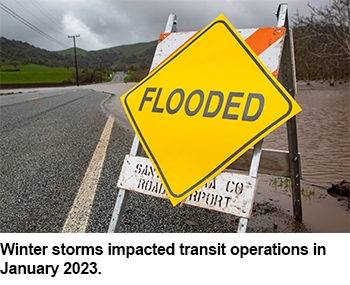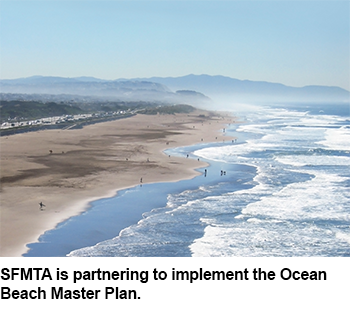Winter Storms Underscore Need for Transit Systems to Increase Resilience
By Jacob Herson
Managing Editor
Transit California
Climate change is a many-headed monster. Californians have been used to worrying about drought, wildfires, and power outages in recent years. Record-setting storms in the winter of 2022-2023 have reminded us that at the turn of a season, severe flooding can be just as much of a hazard to life, private property, and public infrastructure. The winter storms underscore the need for transit systems to increase their resilience in the face of all forms of climate impacts.
“More extreme weather events — such as flooding — as well as the impacts of drought and wildfires are some of the most immediate climate change impacts that have affected the Bay Area in recent years,” said Dave Vautin, Assistant Director of Major Plans for the San Francisco Bay Area Metropolitan Transportation Commission (MTC). “Of course, over the longer term, the impacts of sea level rise threaten critical infrastructure along the Bay shoreline, as well as the Pacific Coast and Delta.” Vautin continued: “Even with just a few feet of sea level rise by mid-century, regional rail lines like SMART and Amtrak could find key segments of track underwater and key corridors like interstate highways could be regularly flooded, requiring diversion of buses to other nearby routes.”
Monique Webster, Regional Government Affairs Manager for the San Francisco Municipal Transit Agency (SFMTA), echoed these concerns about coastal sea level rise: “San Francisco has almost 30 miles of shoreline, and our current challenge is to build a multimodal transportation system that will be resilient in the face of projected climate impacts such as extreme precipitation and sea level rise. This includes creating more redundancy in our transit network so that if one area is affected, that does not lead to system wide delays or service interruptions.” 
SFMTA said its existing winter preparation plan has been effective in keeping the subway dry and its buses and trains running. The agency saw challenges with its traction power system. Webster said, “Our traction power system is over 50 years old, and while it has not traditionally been a source of service disruptions, this type of event demonstrates the need for strong and sustained investment in our infrastructure.” The agency saw power issues at its Green Facility, leaving it reliant on the Muni Metro East facility, which cut the number of available rail vehicles in half, forcing Muni to run single-car trains on most of its lines, which resulted in crowding issues.
Challenges vary, of course, for agencies located inland, like the Tahoe Transportation District. District Manager Carl Hasty said his agency’s biggest climate adaptation challenges include: “Managing the electrification transition with unreliable power grids and maintaining service reliability; planning for wildfire evacuations with limited roadways with peak visitor demands; unstable steep slopes, rain-on-snow events, wildfires, snow removal and pavement degradation; and communication system protocol gaps and system network deficiencies, and roadway closures/reopenings.”
For Placer County Transit/Tahoe Area Regional Transit, simply complying with the zero-emission transition mandates set by the California Air Resource Board (CARB) constitutes the greatest climate adaptation challenge. “Our bus routes have long routes and will face challenges with battery electric bus range,” said Will Garner of the Placer County Department of Public Works. “Also, it is going to be difficult to meet the implementation deadlines.”
Vautin of MTC said tens to hundreds of billions of dollars will be required to make the necessary resilience increases, emphasizing the need for local and regional planning and community-driven solutions. MTC’s Plan Bay Area 2050 includes some such strategies.
“For example,” said Vautin, “to ensure that critical infrastructure can still operate in the event of increasingly frequent and increasingly severe natural disasters, we recommend that public buildings and facilities, including those owned by transportation agencies, be prioritized for investments in resilient power systems to ensure they can keep functioning in the event of power outages. Similarly, investments along the shoreline can help to mitigate impacts of flood events and prepare for rising tides in the decades ahead.”
Vautin emphasized that “rather than thinking about climate adaptation on a system-by-system basis, we must break out of silos and embrace holistic solutions that protect existing infrastructure as well as the communities it serves.” He highlighted the South Bay Shoreline project, “which improves protection for equity priority communities, critical non-transportation infrastructure, a busy state highway (State Route 237), and the Santa Clara Valley Transportation Authority (VTA) light rail line just south of that highway corridor — rather than just thinking of each asset’s protective approach in isolation.” 
SFMTA is working with Caltrans, the Coastal Commission, and the National Park Service to implement the Ocean Beach Master Plan to protect critical municipal infrastructure, improve public access, and address sea level rise. The agency is also partnering with the Port of San Francisco on the Waterfront Resilience Program to reduce the flood and earthquake risk along 7.5 miles of the city’s waterfront and improve its critical transportation infrastructure.
“Some options include preserving and protecting the waterfront so that it can function much as it currently does but with improvements to stormwater management, bridges, roads and railways,” said Webster. “Others involve integrating green infrastructure into our urban fabric and transforming the city’s infrastructure to align with natural watersheds.” One recently completed project, Islais Creek Adaptation Strategy, was funded by Caltrans and strengthens the multimodal transportation infrastructure that connects San Francisco’s historically underserved Bayview community with other neighborhoods.
For Tahoe Transportation District, solutions to the electrification challenge include “evaluation of all fuel types, redundancy, backup systems, and addressing the grid reliability,” said Hasty. For wildfire evacuations, it’s “evacuation scenario planning and coordination, powerline undergrounding with transportation projects on evacuation routes, hardening and improving the communication infrastructure, alternative transportation solutions such as the passenger ferry project, and transit priority lanes that can be used for evacuations.”
When it comes to the impacts of rain and snow, Hasty looks to “slope assessment and stabilization through erosion control, re-vegetation, and scaling to control rockfall, upgrade of snow removal equipment and practices, improved pavement condition management, and workforce development for more responsive treatment during and after events.” Communication issues, finally, call for “upgrade of the Wi-Fi and broadband network from a rural system capacity to urban capacity to address demand and improve real-time communication with the traveler, and improved agency coordination protocols and practices for road closures, openings, and traffic management including across state lines.”
Hasty cited accomplishments, such as the completion of preliminary project planning for a passenger ferry and the completion of assessment of potential regional user-fee approaches to provide sustainable funding for implementation. He said other promising efforts are in the works, including a transportation-led regional emergency management plan, a regional zero-emissions transit implementation plan, and cross-jurisdictional corridor planning and implementation for multi-modal and safety improvements and operations, with the Nevada State Route 28 Corridor as an example.
Beyond the need for additional funding to advance these efforts, Hasty emphasized the importance of “thoughtful planning and design, an inter-agency culture of coordination and implementation, and workforce development, as most organizations seem understaffed.”
Placer County Transit/Tahoe Area Regional Transit is meanwhile currently conducting its Zero-Emission Bus Transition Plan for both operations. “That will feed into a full design and specifications for bus charging facilities at our two separate locations,” said Garner. He cited the need for additional funding to build charging stations and procure buses, as well as the need for assistance from the agency’s two electric utilities to meet power needs.
Vautin concluded: “While there are challenges outside of the financial sphere — for example, figuring out how to expedite approvals of complex yet critical resilience projects to efficiently tackle these growing challenges in the coming years — funding remains the primary challenge. As a new and emerging issue area, existing funding programs in this space tend to be one-time sources or smaller-scale pilot efforts. Increased ongoing federal and state assistance in this space will be critical, especially as the costs of climate change continue to grow in the years ahead.”